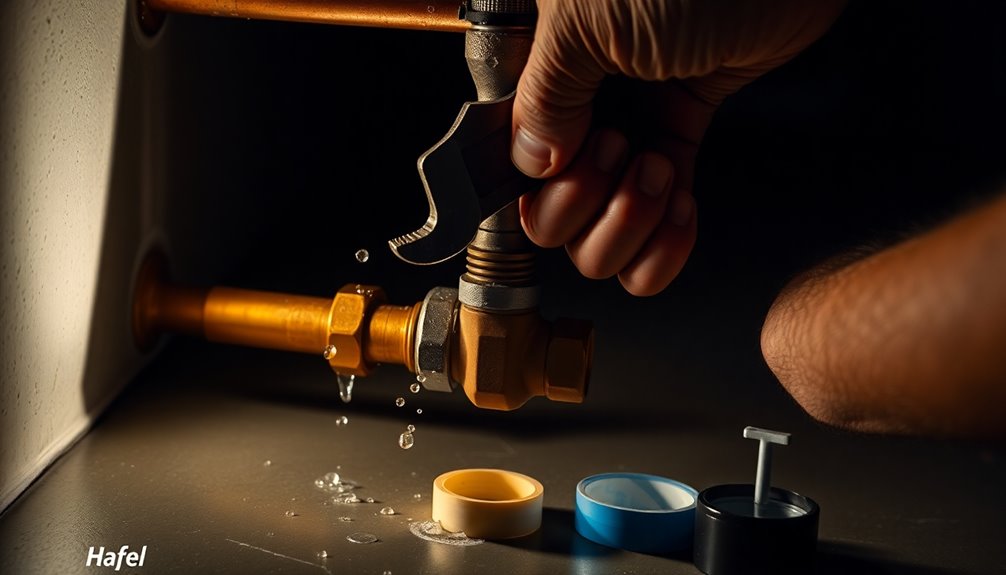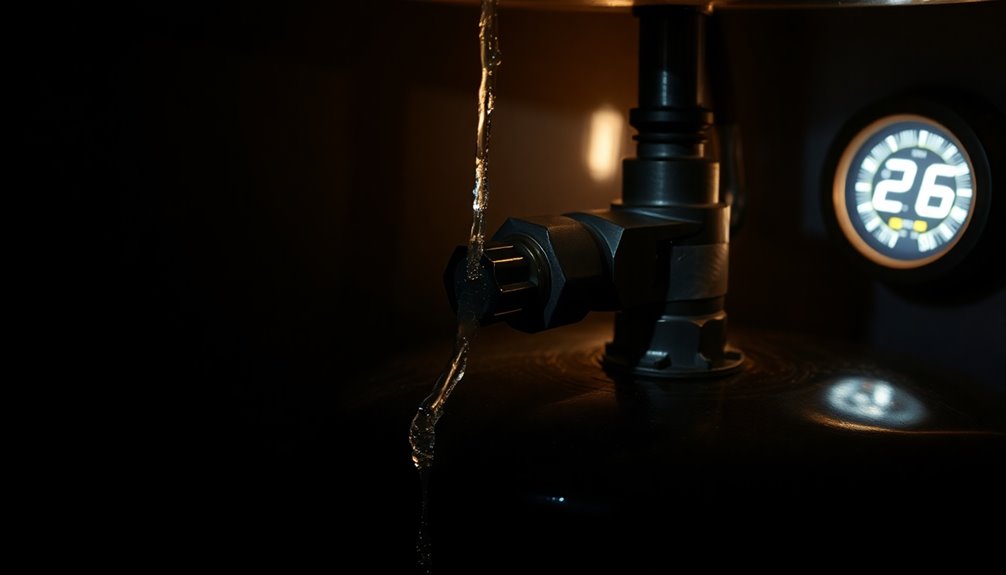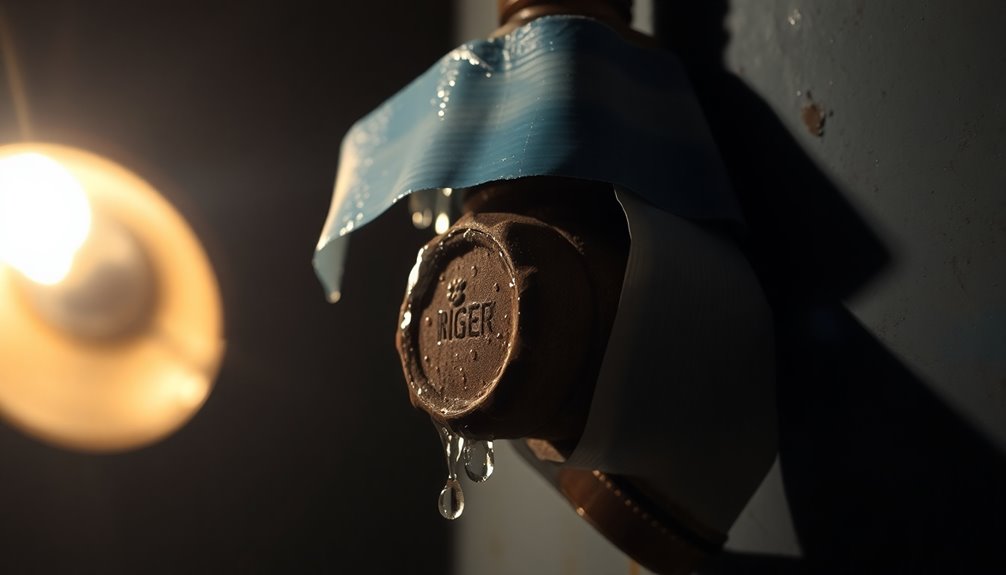If your water heater's pressure relief valve is leaking at night, it might stem from high water pressure or temperature issues. Start by checking your pressure levels with a gauge; they should stay below 80 psi. Tighten the valve with a wrench if it seems loose, but if leaks persist, you may need to replace it. Regular maintenance can prevent future leaks. Stick around to learn more about keeping your water heater in top shape!
Understanding the Pressure Relief Valve
When you think about your water heater, the pressure relief valve (PRV) mightn't be the first thing that comes to mind, but it's vital for your safety.
The PRV opens to release excess pressure when it exceeds 150 psi or 210°F, preventing potential explosions. If you notice leaks, it could indicate a defective valve or issues with water pressure or temperature. Regularly using investment tracking tools can help you understand the costs associated with repairs and replacements, thereby enhancing your financial management. Additionally, monitoring savings is crucial for identifying unexpected expenses related to home maintenance.
It's important to guarantee the correct type of PRV is installed; using the wrong valve can lead to malfunctions. Regular maintenance, like testing the PRV by lifting its lever, guarantees it functions properly and mitigates leaks caused by debris. Additionally, expense tracking tools can help you manage costs effectively when addressing repairs or replacements related to plumbing issues.
Common Causes of Leaks
Leaks from a pressure relief valve can signal various underlying issues that need attention. One common cause is excessive water pressure, often exceeding the recommended maximum of 80 psi. If you notice leaks, it might be time to install a pressure reducing valve (PRV). Additionally, high water temperatures above 150°F can lead to increased pressure, prompting the valve to release water. Defective or improperly installed pressure relief valves may also cause leaks, so check that the valve specifications align with your system's needs. Regular audits of the billing procedures can help identify and address related plumbing issues efficiently. Implementing a proactive monitoring system for your plumbing can also help catch potential issues before they lead to leaks.
Calcium buildup around the valve can hinder proper sealing, leading to leaks. Finally, regular maintenance of the expansion tank and ensuring its air pressure is set 2 psi below the static water pressure can help prevent fluctuations that cause leaks. Implementing regular maintenance practices can enhance financial organization, allowing you to manage expenses effectively when addressing repairs.
Initial Steps to Diagnose the Problem

To start diagnosing your leaking water heater pressure relief valve, check your home's water pressure levels using a gauge.
Next, inspect the pressure relief valve for any signs of damage, and evaluate the expansion tank settings to verify they're correct. Understanding your financial reporting can help allocate funds for potential repairs or replacements. Maintaining accurate financial reporting can assist in budgeting for repairs and replacements as needed. Additionally, utilizing budgeting tools can provide insights on how to manage expenses related to home maintenance effectively.
Check Water Pressure Levels
Checking your water pressure levels is essential for diagnosing issues with your water heater. Use a pressure gauge connected to a hose bibb to measure the current water pressure. Make certain it doesn't exceed the recommended maximum of 80 psi, as high water pressure can lead to leaks from the pressure relief valve. If readings are above 80 psi, consider installing a pressure reducing valve (PRV) to regulate flow. Don't forget to check the air pressure in the expansion tank, ideally set to 2 psi below the static water pressure.
| Pressure Type | Recommended Level | Action Required |
|---|---|---|
| Static Water Pressure | ≤ 80 psi | Monitor regularly |
| Expansion Tank Pressure | 2 psi below static | Adjust as needed |
| Pressure Relief Valve | 150 psi | Verify proper specifications |
| Water Heater Temp | 210°F | Verify compatibility |
Inspect Pressure Relief Valve
Inspecting the pressure relief valve is essential for diagnosing potential leaks in your water heater.
Start by checking the valve for any signs of wear, damage, or improper installation, as a faulty valve can lead to leaks.
Use a pressure gauge to measure the water pressure in your system; if it exceeds 80 psi, you may have excessive pressure that could cause the valve to leak.
Look for calcium buildup or debris around the valve, which can prevent proper sealing.
Regularly test the valve by lifting its lever to release water—ensure it closes properly afterward.
If water continues to drip after testing, the pressure relief valve might need replacement to prevent further leaks.
Evaluate Expansion Tank Settings
After ensuring the pressure relief valve is in good condition, turn your attention to the expansion tank settings.
First, check the air pressure in the expansion tank when the water system isn't pressurized for an accurate reading. The air pressure should be set to 2 psi below the static water pressure.
This adjustment helps the expansion tank absorb excess pressure effectively, preventing fluctuations that could cause the pressure relief valve to leak.
If the expansion tank is faulty or incorrectly set, it can lead to excessive pressure build-up, resulting in potential leaks.
Regularly maintaining the air pressure in the expansion tank allows you to catch issues early, saving you from costly repairs down the line.
How to Tighten or Replace the Valve
If you notice a leak from your water heater's pressure relief valve, addressing it promptly is essential to prevent further issues. Budgeting for home maintenance can help ensure you have funds available for repairs and emergencies, which leads to long-term financial goals. Utilizing budgeting apps can also provide insights into your spending habits, allowing you to allocate resources effectively.
First, try to tighten the valve by using a wrench to turn it clockwise until secure, but be careful not to overtighten and risk damage.
If that doesn't stop the valve leaks, you may need to replace the valve.
Start by turning off the water supply and draining the tank to relieve pressure.
Unscrew the faulty valve and make sure your new valve has a pressure rating of 150 psi and a temperature rating of 210°F.
After installation, lift the lever to flush out debris and monitor for leaks when you restore the water supply.
Always wear safety gear! Additionally, consider researching brands for ethical practices to ensure you choose a reliable and sustainable replacement valve.
Monitoring Temperature and Pressure Levels

Regularly monitoring temperature and pressure levels in your water heater system is essential for safe and efficient operation. Use a meat thermometer to check the water temperature at fixtures, ideally keeping it around 120°F. Temperatures exceeding 150°F can lead to valve leaks. Additionally, utilize a pressure gauge to measure your plumbing system's pressure, ensuring it stays below the recommended maximum of 80 psi. Budget apps can also assist in tracking expenses related to maintenance and repairs, helping you budget effectively. Implementing automated processes can streamline your expense tracking and further enhance your budgeting efforts.
| Measurement | Recommended Level |
|---|---|
| Water Temperature | 120°F |
| Maximum Water Pressure | 80 psi |
| Expansion Tank Pressure | 2 psi below static |
| Valve Condition | Regularly checked |
If you notice leaks, check for high temperatures or excessive pressure; these are common causes of valve failure. Implementing automated notifications can help ensure that you regularly monitor these levels to prevent issues.
Preventative Maintenance Tips
To keep your water heater running smoothly and prevent leaks, it's crucial to stay on top of preventative maintenance.
First, regularly check the air pressure in your expansion tank; it should be 2 psi below your static water pressure. Monitor your home's water pressure with a gauge to confirm it stays below the recommended maximum of 80 psi.
Schedule annual maintenance for your water heater, including testing the temperature and pressure relief (TPR) valve to verify it opens correctly under high pressure. Inspect and clean the TPR valve periodically to prevent calcium buildup that can affect its sealing.
Finally, use a water filter to reduce debris that may block or damage your valves, prolonging their lifespan and confirming efficient water heating.
Conclusion
In summary, tackling a troublesome water heater pressure valve leak doesn't have to be an intimidating dilemma. With a bit of diligence and DIY determination, you can deftly diagnose and address the issue. Remember to monitor your machine's temperature and pressure, keeping it in tip-top shape. By practicing proactive preventative maintenance, you'll prolong your water heater's life and prevent pesky problems from popping up. Stay savvy, and your system will serve you splendidly for years to come!



